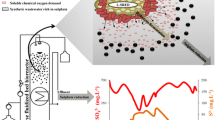Abstract
Biosorption of metals by microorganisms is a promising technology to remove accumulated non-process elements in highly recycled biorefinery process water. Removal of these elements would enable greater water reuse and reduce the environmental impact of effluent discharge. A model lignocellulosic ethanol biorefinery wastewater was created based on pulp mill effluent. This generated a wastewater with an environmentally realistic high loading of dissolved natural organic matter (900 mg/l), a potentially important factor influencing metal biosorption. Analysis of feedstock and pulp mill effluent indicated that Mn and Zn are likely to be problematic in highly recycled lignocellulosic ethanol biorefinery process water. Therefore, the growth of several bacteria and fungi from existing collections, and some isolated from pulp mill effluent were tested in the model wastewater spiked with Mn and Zn (0.2 mM). Wastewater isolates grew the best in the wastewater. Metal uptake varied by species and was much greater for Zn than Mn. A bacterium, Novosphingobium nitrogenifigens Y88T, removed the most metal per unit biomass, 35 and 17 mg Mn/g. No other organism tested decreased the Mn concentration. A yeast, Candida tropicalis, produced the most biomass and removed the most total metal (38 % of Zn), while uptake per unit biomass was 24 mg Zn/g. These results indicate that microorganisms can remove significant amounts of metals in wastewater with high concentrations of dissolved natural organic matter. Metal sorption by autochthonous microorganisms in an anaerobic bioreactor may be able to extend water reuse and therefore lower the water consumption of future biorefineries.





Similar content being viewed by others
References
Addison SL, Foote SM, Reid NM, Lloyd-Jones G (2007) Novosphingobium nitrogenifigens sp. nov., a polyhydroxyalkanoate-accumulating diazotroph isolated from a New Zealand pulp and paper wastewater. Int J Syst Evol Microbiol 57(11):2467–2471. doi:10.1099/ijs.0.64627-0
American Public Health Association (APHA) (2005) Inductively coupled plasma/mass spectrometry (ICP/MS) method 3125B. In: Standard methods for the examination of water and wastewater, 21st ed. APHA, Washington
Barns SM, Lane DJ, Sogin ML, Bibeau C, Weisburg WG (1991) Evolutionary relationships among pathogenic Candida species and relatives. J Bacteriol 173(7):2250–2255
Berdicevsky I, Duek L, Merzbach D, Yannai S (1993) Susceptibility of different yeast species to environmental toxic metals. Environ Pollut 80(1):41–44
Borrok D, Aumend K, Fein JB (2007) Significance of ternary bacteria-metal-natural organic matter complexes determined through experimentation and chemical equilibrium modeling. Chem Geol 238(1–2):44–62
Bruns T, Gardes M (1993) Molecular tools for the identification of ectomycorrhizal fungi: taxon-specific oligonucleotide probes for suilloid fungi. Mol Ecol 2(4):233–242
Burnett P-GG, Handley K, Peak D, Daughney CJ (2007) Divalent metal adsorption by the thermophile Anoxybacillus flavithermus in single and multi-metal systems. Chem Geol 244(3–4):493–506
Choudhury R, Srivastava S (2001) Mechanism of zinc resistance in Pseudomonas putida strain S4. World J Microbiol Biotechnol 17(2):149–153. doi:10.1023/a:1016666000384
Crane RS, Barton P, Cartmell E, Coulon F, Hillis P, Judd SJ, Santos A, Stephenson T, Lester JN (2010) Fate and behaviour of copper and zinc in secondary biological wastewater treatment processes: I. Evaluation of biomass adsorption capacity. Environ Technol 31(7):705–723. doi:10.1080/09593330.2010.481314
Creed JT, Brockhoff CA, Martin TD (1994) Determination of trace elements in waters and wastes by inductively coupled plasma—mass spectrometry. Method 200.8. Revision 5.4. United States Environmental Protection Agency (USEPA), Cincinnati
de Schamphelaere KAC, Vasconcelos FM, Tack FMG, Allen HE, Janssen CR (2004) Effect of dissolved organic matter source on acute copper toxicity to Daphnia magna. Environ Toxicol Chem 23(5):1248–1255
Di Toro DM, Allen HE, Bergman HL, Meyer JS, Paquin PR, Santore RC (2001) Biotic ligand model of the acute toxicity of metals. 1. Technical basis. Environ Toxicol Chem 20(10):2383–2396. doi:10.1002/etc.5620201034
Franklin NM, Adams MS, Stauber JL, Lim RP (2001) Development of an improved rapid enzyme inhibition bioassay with marine and freshwater microalgae using flow cytometry. Arch Environ Contam Toxicol 40(4):469–480. doi:10.1007/s002440010199
Gadd GM (2009) Biosorption: critical review of scientific rationale, environmental importance and significance for pollution treatment. J Chem Technol Biotechnol 84(1):13–28. doi:10.1002/jctb.1999
Glover CN, Hogstrand C (2002) In vivo characterisation of intestinal zinc uptake in freshwater rainbow trout. J Exp Biol 205(1):141–150
Gu Y, Edwards L (2004) Prediction of metals distribution in mill processes, Part 2: fiber line metals profiles. Tappi J 3(2):13–20
Guillén Y, Navias D, Machuca Á (2009) Tolerance to wood preservatives by copper-tolerant wood-rot fungi native to south-central Chile. Biodegrad 20(1):135–142. doi:10.1007/s10532-008-9207-1
Habets L, Driessen W (2007) Anaerobic treatment of pulp and paper mill effluents—status quo and new developments. Water Sci Technol 55(6):223–230. doi:10.2166/wst.2007.232
Harrison JJ, Rabiei M, Turner RJ, Badry EA, Sproule KM, Ceri H (2006) Metal resistance in Candida biofilms. FEMS Microbiol Ecol 55(3):479–491
Hill J, Nelson E, Tilman D, Polasky S, Tiffany D (2006) Environmental, economic, and energetic costs and benefits of biodiesel and ethanol biofuels. Proc Natl Acad Sci U S A 103(30):11206–11210. doi:10.1073/pnas.0604600103
Jemaa N, Thompson R, Paleologou M, Berry RM (1999) Non-process elements in the kraft recovery cycle, Part I: sources, levels and process effects. Pulp Pap Can 100(9):T292–T296
Kanto Öqvist C, Kurola J, Pakarinen J, Ekman J, Ikävalko S, Simell J, Salkinoja-Salonen M (2008) Prokaryotic microbiota of recycled paper mills with low or zero effluent. J Ind Microbiol Biotechnol 35(10):1165–1173. doi:10.1007/s10295-008-0396-8
Kaushik S, Juwarkar A, Malik A, Satya S (2008) Biological removal of Cr(VI) by bacterial isolates obtained from metal contaminated sites. J Environ Sci Health Part A 43(4):419–423. doi:10.1080/10934520701795665
Kiiskia E (1994) The effects of water circuit closure in a pulp mill. Pap Puu 76(9):574–579
Kim G-H, Son D-S, Kim J–J (2005) Fungi colonizing Douglas Fir in cooling towers: identification and their decay capabilities. Wood Fiber Sci 37(4):638–642
Lane D (1991) 16S/23S rRNA sequencing. In: Stackebrandt E, Goodfellow M (eds) Nucleic acid techniques in bacterial systematics. Wiley, Chichester, pp 115–175
Lastra A, Gómez D, Romero J, Francisco JL, Luque S, Álvarez JR (2004) Removal of metal complexes by nanofiltration in a TCF pulp mill: technical and economic feasibility. J Membr Sci 242(1–2):97–105
Liang Q, Lloyd-Jones G (2010) Sphingobium scionense sp. nov., an aromatic hydrocarbon-degrading bacterium isolated from contaminated sawmill soil. Int J Syst Evol Microbiol 60:413–416. doi:10.1099/ijs.0.008144-0
MacDiarmid CW, Milanick MA, Eide DJ (2003) Induction of the ZRC1 metal tolerance gene in zinc-limited yeast confers resistance to zinc shock. J Biol Chem 278(17):15065–15072. doi:10.1074/jbc.M300568200
Mantoura RFC, Dickson A, Riley JP (1978) The complexation of metals with humic materials in natural waters. Estuar Coast Mar Sci 6(4):387–408
McCarthy JK, Hood IA, Brockerhoff EG, Carlson CA, Pawson SM, Forward M, Walbert K, Gardner JF (2010) Predicting sapstain and degrade in fallen trees following storm damage in a Pinus radiata forest. For Ecol Manag 260(9):1456–1466
Merrick & Company (1998) Wastewater treatment options for the biomass-to-ethanol process. Project no. 19013104, task 6. Report to the National Renewable Energy Laboratory
Mikes J, Siglova M, Cejkova A, Masak J, Jirku V (2005) The influence of heavy metals on the production of extracellular polymer substances in the processes of heavy metal ions elimination. Water Sci Technol 52(10–11):151–156
Novis P, Halle C, Wilson B, Tremblay L (2009) Identification and characterization of freshwater algae from a pollution gradient using rbcL sequencing and toxicity testing. Arch Environ Contamin Toxicol 57(3):504–514. doi:10.1007/s00244-009-9312-0
Nurmesniemi H, Pöykiö R, Perämäki P, Kuokkanen T (2005) The use of a sequential leaching procedure for heavy metal fractionation in green liquor dregs from a causticizing process at a pulp mill. Chemosphere 61(10):1475–1484
Oberoi HS, Vadlani PV, Brijwani K, Bhargav VK, Patil RT (2010) Enhanced ethanol production via fermentation of rice straw with hydrolysate-adapted Candida tropicalis ATCC 13803. Process Biochem 45(8):1299–1306
Prigione V, Zerlottin M, Refosco D, Tigini V, Anastasi A, Varese GC (2009) Chromium removal from a real tanning effluent by autochthonous and allochthonous fungi. Bioresour Technol 100(11):2770–2776
R Development Core Team (2010) R: a language and environment for statistical computing. R Foundation for Statistical Computing, Vienna. http://www.R-project.org
Rehman A, Anjum M (2011) Multiple metal tolerance and biosorption of cadmium by Candida tropicalis isolated from industrial effluents: glutathione as detoxifying agent. Environ Monit Assess 174(1):585–595. doi:10.1007/s10661-010-1480-x
Rippon J, Gerhold R, Heath M (1980) Thermophilic and thermotolerant fungi isolated from the thermal effluent of nuclear power generating reactors: dispersal of human opportunistic and veterinary pathogenic fungi. Mycopathologia 70:169–179
Rodrigues de Miranda L (1978) A new genus: Sporopachydermia. Antonie Van Leeuwenhoek 44(3):439–450. doi:10.1007/bf00394320
Santos A, Judd S (2010) The fate of metals in wastewater treated by the activated sludge process and membrane bioreactors: a brief review. J Environ Monit 12(1):110–118
Shapiro H (2003) Practical flow cytometry, 4th edn. Wiley-Liss, New York
Silva RMP, Rodriguez AA, De Oca J, Moreno DC (2009) Biosorption of chromium, copper, manganese and zinc by Pseudomonas aeruginosa AT18 isolated from a site contaminated with petroleum. Bioresour Technol 100(4):1533–1538. doi:10.1016/j.biortech.2008.06.057
Somerville C, Youngs H, Taylor C, Davis SC, Long SP (2010) Feedstocks for lignocellulosic biofuels. Sci 329(5993):790–792. doi:10.1126/science.1189268
Suihko M-L, Hoekstra E (1999) Fungi present in some recycled fibre pulps and paperboards. Nordic Pulp Pap Res J 14:202–206
Tourney J, Ngwenya BT, Mosselmans JWF, Magennis M (2009) Physical and chemical effects of extracellular polymers (EPS) on Zn adsorption to Bacillus licheniformis S-86. J Colloid Interface Sci 337(2):381–389. doi:10.1016/j.jcis.2009.05.067
Tourney J, Ngwenya BT, Mosselmans JWF, Tetley L, Cowie GL (2008) The effect of extracellular polymers (EPS) on the proton adsorption characteristics of the thermophile Bacillus licheniformis S-86. Chem Geol 247(1–2):1–15
Vijayaraghavan K, Yun Y-S (2008) Bacterial biosorbents and biosorption. Biotechnol Adv 26(3):266–291
Visser P, Ibelings B, Mur L, Walsby A, Huisman J, Matthijs H (2005) The ecophysiology of the harmful cyanobacterium Microcystis. In: Huisman J, Matthijs H, Visser P (eds) Harmful Cyanobacteria, vol 3. Aquatic Ecology Series. Springer, Netherlands, pp 109–142. doi:10.1007/1-4020-3022-3_6
Vörösmarty CJ, Green P, Salisbury J, Lammers RB (2000) Global water resources: vulnerability from climate change and population growth. Sci 289(5477):284–288. doi:10.1126/science.289.5477.284
Wang H, Gielen GJH, Judd MC, Stuthridge TR, Blackwell BG, Tomer MD, Pearce SH (1999) Treatment efficiency of land application for thermo-mechanical pulpmill (TMP) effluent constituents. Appita J 52(5):383–386
Worsey MJ, Williams PA (1975) Metabolism of toluene and xylenes by Pseudomonas putida (arvilla) mt-2: evidence for a new function of the TOL plasmid. J Bacteriol 124:7–13
Yarita K, Sano A, Murata Y, Takayama A, Takahashi Y, Takahashi H, Yaguchi T, Ohori A, Kamei K, Miyaji M, Nishimura K (2007) Pathogenicity of Ochroconis gallopava isolated from hot springs in Japan and a review of published reports. Mycopathologia 164(3):135–147. doi:10.1007/s11046-007-9034-7
Acknowledgments
We thank Sally Gaw and Rob Stainthorpe (University of Canterbury) for metals analysis; Matt Stott and Chris Daughney (Institute of Geological and Nuclear Sciences, GNS) for valuable scientific input; Phil Novis (Landcare Research) for providing Scenedesmus sp. and Chlorella sp.; Susie Wood (Cawthron Research) for providing Microcystis wesenbergii and other algae; Tripti Singh (Scion, Rotorua) for providing the Trichoderma viride, Trametes versicolor and Antrodia xantha; Ben MacDonald and Katrin Walbert (Scion). Funding provided by the Foundation for Research, Science and Technology (FRST) programme CO4 × 0801.
Conflict of interest
This research was funded by the Foundation of Research, Science and Technology (FRST). The funding agency had no scientific input into the study, and the authors declare that they have no conflict of interest.
Ethical standard
All experiments were conducted in accordance with New Zealand law, with particular attention to the Ministry of Agriculture and Forestry/Environmental Risk Management Authority policies regarding PC1 and PC2 containment facilities.
Author information
Authors and Affiliations
Corresponding author
Rights and permissions
About this article
Cite this article
Palumbo, A.J., Taylor, S.C., Addison, S.L. et al. Metal biosorption in lignocellulosic biofuel biorefinery effluent: an initial step towards sustainability of water resources. J Ind Microbiol Biotechnol 39, 1345–1356 (2012). https://doi.org/10.1007/s10295-012-1129-6
Received:
Accepted:
Published:
Issue Date:
DOI: https://doi.org/10.1007/s10295-012-1129-6




